|
Weekend
1 round-up, 15-16 November 2014
-
John Saunders
The 22nd season of the 4NCL (British Team
League) got underway on 15 November 2014.
Running one’s eye down the squads for this
season, it rather looks as if Guildford are
the stand-out favourites to win their third
successive title, and their sixth in total
(which, if achieved, would equal Wood
Green’s tally of championships). Once again
the Surrey team enjoy the generous patronage
of Roger Emerson, whom readers of these
reports will recall twirling his samurai
sword at a team pep talk before last year’s
decider. The sword, I should add, had a
blunt edge and was just for show, but his
team the next day was razor-sharp: Guildford
beat Wood Green HK by 6-2. To find the last
time Guildford’s first team didn’t win a
match you have to go back to the final match
of the 2012/13 season when a 4-4 draw with
the same team was still good enough to win
them the title.
I suppose the simplest way to assess a
squad’s potential strength would be to play
a quick game of ‘count the grandmaster’.
Guildford’s GM count is 11, and most of them
were present for the first round of matches
(six in the first team and two in the
second). Wood Green HK (who field just the
one team) have eight but only two of them
played at this weekend. Cheddleton have a
healthy six. Barbican, White Rose and
Blackthorne Russia have two each, and
e2e4.org.co.uk one. 3Cs also have one GM but
they currently languish in the second
division. So, on the face of it, Cheddleton
look to be the nearest thing Guildford 1
have to rivals for the championship (with
the possible exception of the Surrey club’s
own second team). Guildford 1 and Cheddleton
are both in the same preliminary group and
are fated to meet in the sixth round in
February.
Round 1 - Division 1a
|
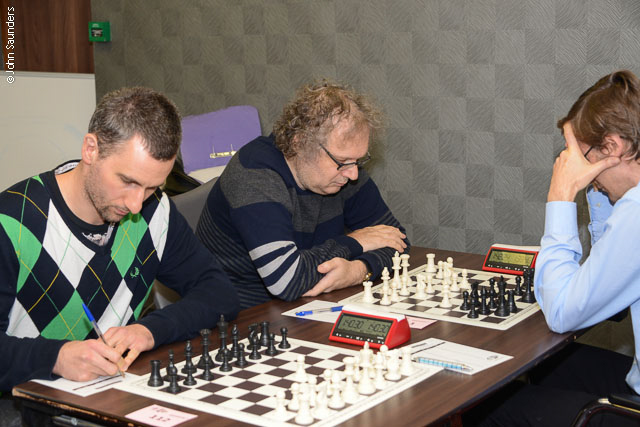 |
| Andrew
Greet, Jon Speelman, Geoff Lawton |
But enough of looking into the future:
let’s see how the teams performed in their
November matches. Wood Green HK, with their
reduced patronage, were some way short of
their traditional strength against
Warwickshire Select, newly promoted from
Division 2. The Midlands side fully
capitalised on the boards lacking titled
players at the lower end of the Wood Green
team but this wasn’t enough to make up for
some hefty disparities in strength higher up
the board order. Jon Speelman got his 4NCL
season off to a good start against Geoff
Lawton.
4NCL
2014/15, Division 1a, Round 1
Jon
Speelman (Wood Green HK)
Geoff
Lawton (Warwickshire Select)

25.Re6!
A familiar exchange sacrifice, cutting
Black’s position in half and ramping up the
pressure on the f5–pawn. 25...Bxe6
26.dxe6 Rf6 27.Nh5 Necessary precision:
it would be all too easy for we lesser
mortals to proceed with something like
27.Bxf5?! Rb8 when Black can generate a bit
of queenside counterplay with ...b7–b5, and
it would be hard to move the bishop from f5
because of the weak f4–pawn. 27...Kh8
28.g3 Qg8 29.Nxf6 Bxf6 30.Bxf5 Qg7 31.Re2
Rg8 32.Rg2 Bd4 33.Qe2 Qf6 34.Bd3 Rb8 35.Qe4
1-0 I suppose Black could soldier on
with 35...Qg7 36.b3 but the white kingside
pawns soon roll forward and the long-term
prospect of an opposite-coloured bishop
endgame is just a pipe-dream.
The ADs, with an average rating of 2187,
could be in for some relegation problems
this season unless they strengthen their
squad, and they were well beaten by Barbican
1. Incidentally, though the team’s
abbreviated moniker stands for ‘The
Antediluvians’, the club follows the
refreshing 4NCL tradition for disregarding
the team name completely. Just as Barbican
Youth has been known to field pensioners,
The ADs sport teenagers in their team. A
pretty good one, too: 17-year-old Alan Merry
recently achieved a remarkable GM norm in
the PokerStars Isle of Man International,
even before qualifying as an IM, but he was
brought back to earth in Hinckley by Irish
IM Sam Collins, who played some forceful,
imaginative chess.
|
 |
| Sam
Collins |
4NCL
2014/15, Division 1a, Round 1
Sam
Collins (Barbican 1)
Alan
Merry (The ADs)
1.e4 c5
2.Nf3 Nc6 3.d4 cxd4 4.Nxd4 Nf6 5.Nc3 e6
6.Be2 Bb4 7.0‑0 Known simply as the
Sicilian Gambit, White gives up the e-pawn
(and possibly a second pawn) for a lead in
development and a possible kingside attack.
7...Bxc3 8.bxc3 Nxe4 9.Bd3 Nf6
9...Nxc3!? 10.Qg4 0‑0 11.Bb2 f5 12.Nxf5 exf5
13.Qc4+ d5 14.Qxc3 d4 may give White a
little something for the gambit pawn.
9...d5!? 10.Ba3 Qa5 11.Qc1 has been aired in
some GM games. 10.Bg5!? This seems to
be new. After 10.Nb5 0‑0 11.Ba3, Black has
the option of giving up the exchange or
playing 11...Ne7. 10...Qa5 11.f4!?
White decides to switch to a poker game,
raising the stakes by one pawn. 11...Qxc3
12.Nb5 Qc5+ 13.Kh1 Nd4 14.a4 Nxb5 15.axb5 d6
At first sight 15...d5 looks better, so
that after 16.Qf3 Black can play 16...b6 and
17...Bb7, but instead he might have to
reckon with 16.f5 when 16...e5 17.Qe2 leaves
his position looking slightly vulnerable.
16.Qf3 Nd7 17.Rae1 0‑0 Very committal,
but Black has to do something and other
moves are arguably as tricky, e.g. this
Houdini line: 17...h6 18.Qh3 Nb6 19.Bh4 0‑0
and now the engine suggests 20.Bf6!? Nd5!
(20...gxf6? 21.Qxh6 f5 22.Rf3 leads to mate)
21.Bxg7!? although it may only be good
enough for a draw. 18.Qg3
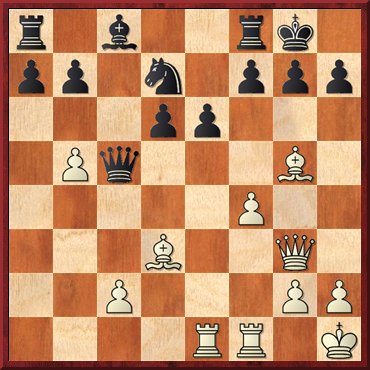
18...Qc7?
Black probably thought he was
jettisoning an exchange for his two extra
pawns but it turns out to be far more
serious than that. Instead, 18...f5! was
probably necessary. Then 19.Rxe6 Ne5! 20.Bh6
Ng4! 21.Re7 Rf7 leads to a perpetual or a
level position. 19.Bh6 g6 20.f5!! The
killer move. Move order is important: not
20.Bxf8? Nxf8 21.f5 exf5 22.Re8 Rb8 and
Black has reasonable prospects of survival.
20...exf5 There is nothing else. If
20...Ne5 21.fxg6 Nxg6 22.Bxg6 hxg6 23.Qg5!
when 23...Qd8 loses to 24.Rxf7!!, etc.
21.Re7! Pinning Black’s only truly
active piece and preparing to smash through
with Bxf5 and Bxg6. 21...Qc5 21...Qd8
22.Qxd6 Qb6 23.Qa3 wins. 22.Rxf5
22.Bxf5 Ne5 23.Qh4 should also win, if
slightly less forcefully. 22...Qd4
22...Ne5 23.Qg5 wins. 23.Bxf8 Nxf8
24.Rfxf7 Be6 25.Rxf8+ Rxf8 26.Rxe6 a5 27.h3
a4 28.Rxd6 Qa1+ 29.Kh2 a3 30.Bc4+ Kh8 31.c3
1-0
Guildford 2 and Blackthorne Russia were
quite well matched but it was the slightly
higher-rated Guildford team which triumphed,
to the tune of 5-3. Dave Smerdon returned to
the scene of his recent 4NCL Rapidplay
Individual success and won again, beating
Danny Gormally in a c3 Sicilian. It was
another case of someone castling into
trouble but White needed to see quite a long
and tricky tactical sequence to figure out
why his position was so good.
4NCL
2014/15, Division 1a, Round 1
Dave
Smerdon (Guildford 2)
Danny
Gormally (Blackthorne Russia)
1.e4 c5
2.c3 Nf6 3.e5 Nd5 4.Nf3 e6 5.d4 cxd4 6.cxd4
b6 7.Nc3 Bb7 7...Nxc3 8.bxc3 Qc7 9.Bd2
Bb7 10.Bd3 d6 11.0‑0 Nd7 is seen rather more
often. 8.Bd3 Na6 9.a3 9.Nxd5 Bxd5
doesn’t hang a piece with 10.Bxa6 as Black
can now play 10...b5 and win it back at the
price of a pawn, if need be. But White
doesn’t usually take the bait with 11.Bxb5?!
because after 11...Qa5+ 12.Bd2 Qxb5, the
white king can’t castle and Black is
probably better. Instead, 11.0‑0 Qb6 is
probably about equal. 9...Be7
9...Nac7 10.Ne4 is quite good for White as
he can play Nd6 and gain a tempo on the c7
knight after the recapture exd6. 10.Ne4
0‑0 Tricky. Black might have to think
about 10...f5 instead. 11.Nfg5! h6
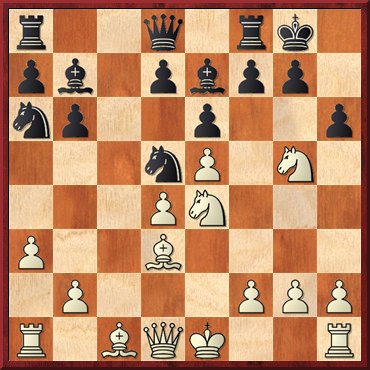
11...g6
gives White a natural target for 12.h4!, not
to mention some weak dark squares.
12.Nh7! Kxh7 Not much option, otherwise
12...Re8 13.Qg4! and White’s attack will
crash through. 13.Nd6+ Kg8 14.Nxb7 Qc8?
A story of two pins. It turns out that
the pin of the knight given by the black
queen is less significant that the one which
the white rook makes along the c-file in a
few moves’ time. 14...Qb8! 15.Bxa6 Nc7 and
now 16.Bxh6? gxh6 and White only has a
perpetual at best. However, 16.Bd3 or 16.Qg4
might still be quite good for White.
15.Bxa6 Nc7 16.Bxh6! gxh6 16...Nxa6
17.Qg4 g6 18.Bxf8 Bxf8 19.Nd6 Bxd6 20.exd6
Qc4 21.h4 leaves White the exchange and a
pawn up, with a powerful kingside attack
into the bargain. Black just cannot mobilise
his forces quickly enough to generate a
counter. 17.Rc1 Qb8 18.Qg4+ Kh8 19.Rc3
Rg8 20.Qh5 Rg7 20...Bf8 21.Nd6 wins.
21.Rh3 Bg5 22.f4 Bxf4 23.0‑0 Good
enough, though 23.Rf1 appears to be a bit
quicker. 23...Qg8 24.Rxf4 Rxg2+ 25.Kf1
Rg1+ 26.Ke2 Qg2+ 27.Kd3 Rd1+ 28.Qxd1 Qxh3+
29.Rf3 Qxh2 30.Bc4 f5 31.exf6 d5 32.Bb3 Qxb2
33.Rh3 Kh7 34.Bc2 e5 35.dxe5 Ne6 36.Kd2+ Kg8
37.Qg4+ 1-0
|
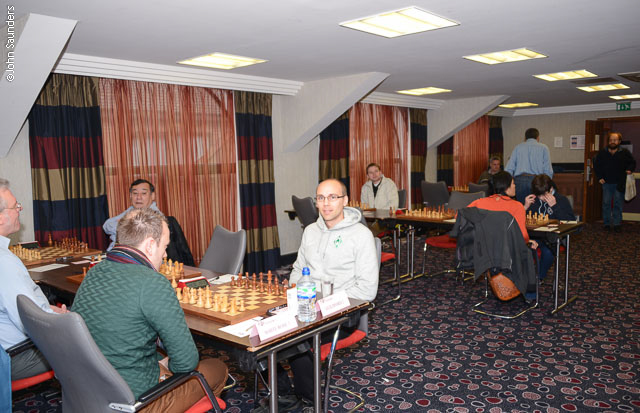 |
| Matthew
Webb (White Rose) v Dave Smerdon
(Guildford 2) |
South Wales Dragons, my own former team,
have done well to win promotion from
Division Two but they have a tough season
ahead of them. They took a 2-6 beating from
White Rose but at least John Cooper had a
good day, beating GM Colin McNab. I would
annotate the game but I’d probably get
accused of favouritism towards the Land of
my Fathers – in fact, the real reason is
that I’m half-Scots and didn’t enjoy someone
from the Land of my Mothers get so horribly
mangled on the White side of an English
Opening (he would have had to find another
opening if the referendum had gone the other
way). Defeat might have been heavier for the
Dragons but for James Cobb managing to grab
a perpetual check in a position where Peter
Wells’s passed pawns were threatening to
push him off the board.
4NCL
2014/15, Division 1a, Round 1
James
Cobb (South Wales Dragons)
Peter
Wells (White Rose)
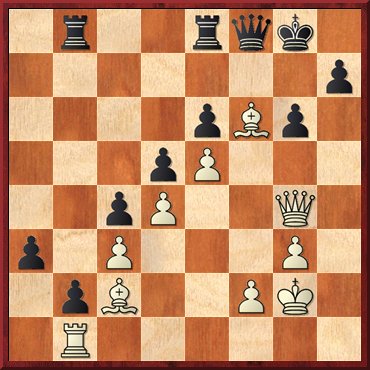
Black to
play and (miss a) win
38...Qf7?
The right way to win is 38...Qh6! when
White can’t do much about the inevitable
threat of ...a3–a2. If he tries 39.Rh1
simply 39...Qxh1+! 40.Kxh1 b1Q+ 41.Bxb1
Rxb1+ 42.Kg2 a2 and White is a dead man
walking. 39.Rh1! Setting up a
perpetual check tactic. Occupation of the
h-file proves to be the decisive factor.
39...Rb7? Interestingly, there was a
still a chance for Black to win with
39...Re7! since 40.Bxg6? now fails to
40...Qxg6 41.Qxg6+ hxg6 42.Rh8+ Kf7 and the
perpetual check opportunity has evaporated.
Instead White has to try 40.Bb1 but Black
can probably eke out a win. 40.Bxg6! Qxg6
41.Qxg6+ hxg6 42.Rh8+ Kf7 43.Rh7+ Kf8
44.Rh8+ Not 44.Rxb7?? a2 and Black still
wins. 44...Kf7 45.Rh7+ ½-½
|
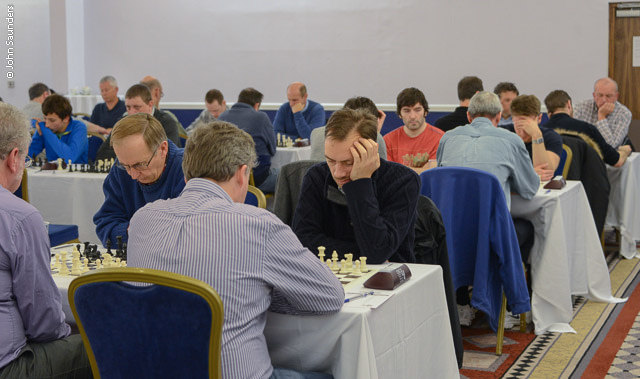 |
| John
Cooper, James Cobb, Adam Ashton |
Round 1 - Division 1b
Guildford 1 got underway with a
comfortable 6½-1½ win against Hackney.
Curiously, both teams had a player called
Suárez in the side but they didn’t play each
other. Had they done so, it might have been
a case of the biter bit. But actually both
lost a rather toothless encounter. Sorry...
that was a purely gratuitous bite-joke,
actually they (Carlos Suárez García and
Alberto Suárez Real, that is) were the
victims of some deftly applied pressure from
Matthew Sadler and Rubén Cenal Gutiérrez
respectively. Bob Eames did well to hold
French super-GM Romain Edouard, rated more
than 400 points above him.
4NCL
2014/15, Division 1b, Round 1
Nick Pert
(Guildford 1)
Tomer
Eden (Hackney)
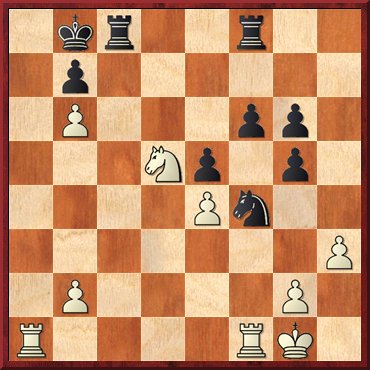
34.Ra5?
34.Ra7 Nxd5 35.exd5 Rcd8 36.Rfa1 Kc8
37.Rc1+ forces 37...Kd7 38.Rxb7+ Kd6 39.Rbc7
and White should win. 34...Rcd8??
34...Nxd5! 35.exd5 Rcd8! and White doesn’t
have anything very convincing, e.g. 36.Rfa1
Kc8 37.Ra7 f5 38.Rc1+ Kb8 39.Rc7 Rxd5
40.Rcxb7+ Kc8 41.Rg7 Kb8 42.Rxg6 Rd1+ 43.Kh2
Rd2 44.Rxg5 f4, etc. 35.Ne7! 1-0
Black cannot avoid mate or heavy material
loss: 35...Rd6 36.Rfa1 Rxb6 37.Ra8+ Kc7
38.Rxf8, etc.
|
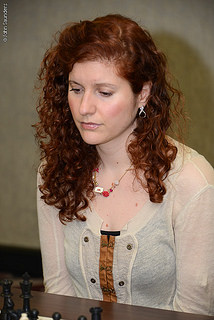 |
|
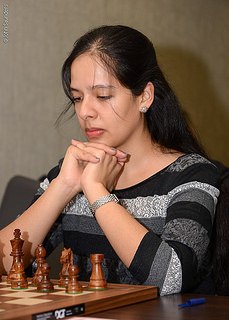 |
|
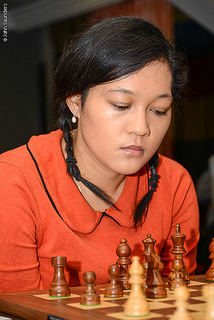 |
|
Jovanka Houska |
|
Kanwal
Bhatia |
|
Sue Maroroa
Jones |
e2e4.org.uk versus Cambridge University
(another team whose players’ connections
with the institution they purported to
represent was for the most part fictional)
was a closely-fought match, with the Uni
beating the URL by the odd point. The match
to some extent turned on an existential
moment in the game Camus-Longson, where
Black (the website man) briefly had his
opponent at his mercy but blew a winning
chance when choosing between pushing a
passed pawn or exchanging a couple of pieces
first. Few of us are a stranger to this
phenomenon – I know I was plagued by it.
Black fought back gamely to create a second
winning chance but, having pushed the rock
up the mountain, it fell down again. The
myth of Sisyphus. (That’s it, I’m out of
Camus references. If you can think of any
more, email me.)
4NCL
2014/15, Division 1b, Round 1
Guillaume
Camus (Cambridge University)
Alex
Longson (e2e4.org.uk)
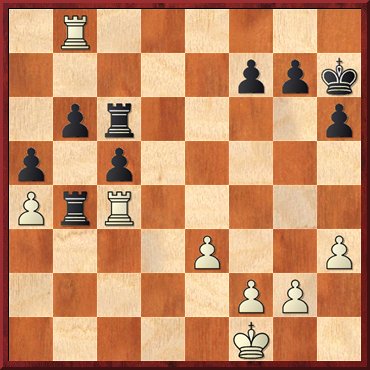
36.Rf4!?
Rather than playing 36.Rc2 and losing
the slow way, White tries a spin of the
dice. Apparently, the French for ‘bluff’ is
‘bluff’. That figures... 36...Rxf4?
Understandable but a mistake. Black doesn’t
want to have to figure out 36...c4 37.Rxf7
c3 38.Rbb7 c2 39.Rxg7+ Kh8 and then
calculate all those checks, but actually
there’s nothing to calculate - White’s got
‘rien de rien’. The black king simply
strolls along the Bois de Boulogne with an
independent air, all the way to c8, and the
checks come to an end. C’est fini.
37.exf4 c4 Now it’s time for the white
king’s promenade... 38.Ke2 c3 39.Kd1 c2+
40.Kc1 Kg6 41.g4 Kf6 42.Rb7 g5 43.f5 Kg7
44.Rb8 Rc4 45.Rxb6 Rxa4 46.Rb3 Rc4 47.Ra3
Rc5 48.Rd3 h5 49.f3? Endangering his
drawing chances by opening up an oblique
path for the black king to penetrate the
kingside. 49...h4 50.Rb3 Rc4 51.Ra3 Kf6
52.Rd3 Rc7 53.Ra3 Ke5! 54.Rxa5+ Kf4 55.f6
Kg3? 55...Rc3! was the right way to
proceed, when 56.Rf5+ Kg3 57.Rxg5 Rxf3
58.Kxc2 Kxh3 59.Rg7 Rxf6 60.g5 Rg6 61.Rxf7
Kg2 is quite a straightforward win.
56.Rxg5 Kxh3 57.Rg7 Kg2 58.g5 h3 59.g6 h2
60.gxf7+ Kf2 61.Rh7 Rxf7 62.Rxh2+ ½-½
|
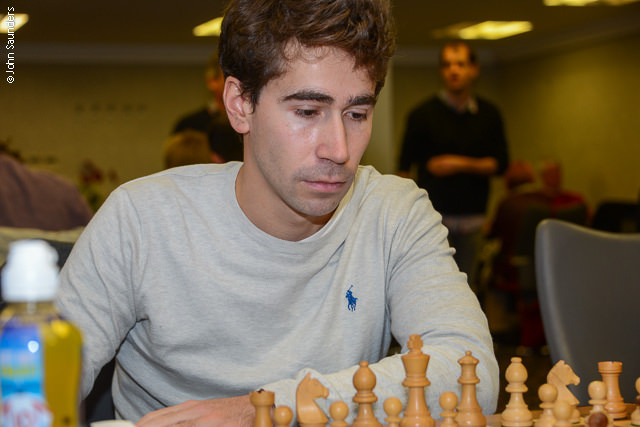 |
| Guillaume
Camus |
This was not the only frustration for the
e2e4.org.uk of the afternoon, with a couple
of other results going against them in time
pressure or the endgame. This one came to a
gruesome finale.
4NCL
2014/15, Division 1b, Round 1
Alan Byron
(e2e4.org.uk)
Carl
Spencer (Cambridge University)
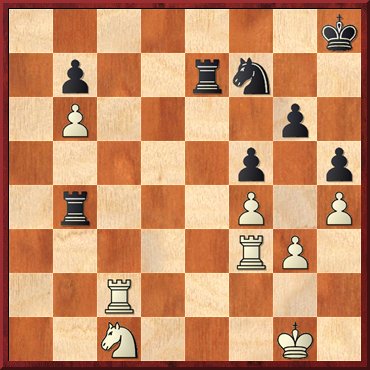
38.Rb3??
In trying to save the b-pawn, White
loses a piece. Instead he could have tried
38.Rfc3 Rxb6 39.Nd3 which costs a pawn, but
he still stands a decent chance of holding
the endgame. 38...Re1+ 39.Kf2 Rxc1!
40.Rxc1 Rxb3 41.Rc7 Nd6 0‑1
Barbican 2 versus Grantham Sharks was a
close match in which four lower-rated
players overcame higher-rated opposition,
with Grantham winning with a better score on
the lower boards. Isaac Sanders soon had
Thomas Rendle in a terrible tangle.
4NCL
2014/15, Division 1b, Round 1
Isaac
Sanders (Barbican 2)
Thomas
Rendle (Grantham Sharks)
1.d4 e6
2.c4 f5 3.g3 Nf6 4.Bg2 c6 5.Nh3 d6 6.Nc3 e5
A bit risky, maybe. 7.dxe5 dxe5
8.Qxd8+ Kxd8 9.Ng5 Ke8 10.e4 Na6 11.0‑0 Nc5
12.exf5 Bxf5 13.Be3 Nd3 Given the
predicament the knight gets into on d3, it’s
tempting to look for something better here.
Maybe 13...h6 14.Bxc5 Bxc5 15.Rae1!? Nd7,
though the e4–pawn looks a bit vulnerable.
14.b3 Bb4 15.Nge4 Ke7?! 16.a3!
Black’s last move deprived him of a
potentially useful retreat square for the
bishop. 16...Bxc3 16...Ba5 17.b4 Bc7
might not be as bad as it looks, though the
black knight still looks a bit lonely on d3.
17.Nxc3 Kd6 18.Rfd1 Kc7 19.Rd2 Rhd8
20.Rad1 h6 After 20...Rd7 21.Bf1 Rad8,
22.Bxa7 becomes possible but perhaps it is
the lesser of two evils: 22...Bg4 23.Ra1
Nc5!? 24.Rb2 Nce4 might offer a glimmer of
compensation for the pawn. 21.Bf1 e4
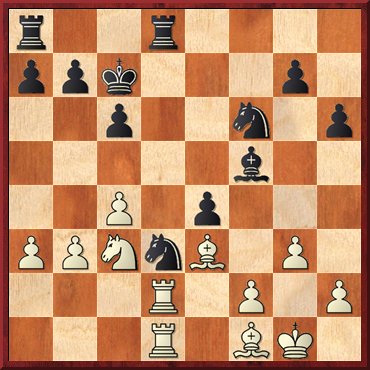
22.Nxe4!
This pulls the rug out from under
Black’s defence. 22...Bxe4 23.Bxd3
White now has a full-value extra pawn.
23...Bf3? A blunder probably born of
desperation. 24.Bf4+ Kb6 25.c5+! Kxc5
26.Be3+ Kd6 27.Be4+ 1-0
|
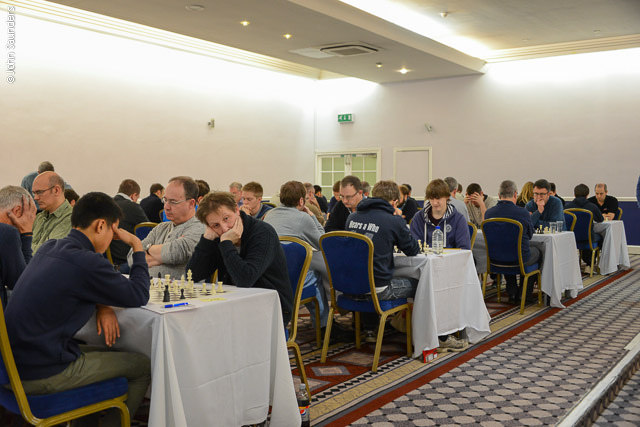 |
| Divisions
1 and 2 |
Graham Morrison gave Holger Grund an even
bigger sharracking on the second board but
thereafter the Sharks were in the ascendant,
winning 5-3. Barbican 2 were a bit
unfortunate. Their captain Jonathan Rogers
had a particularly bleak afternoon, playing
what can only be described as a self-cheapo
– practically forcing his opponent to find a
move winning a piece. David Coleman lost
after missing a fleeting chance at a
brilliant win. But he shouldn’t beat himself
over it – this one looks to be “engines
only”.
4NCL
2014/15, Division 1b, Round 1
David
Coleman (Barbican 2)
Veronica
Foisor (Grantham Sharks)
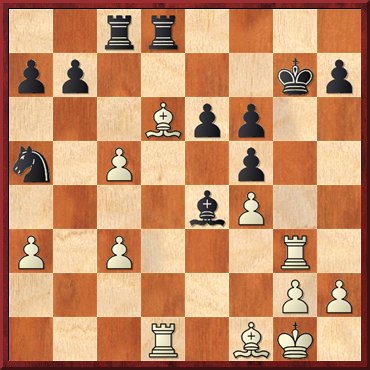
Black has a
choice of three moves. One is obviously bad
but the other two have to be weighed
carefully. 32...Kh6!? It is easy to
see why 32...Kh8? is wrong - White wins with
33.Be7, threatening mate in one and a rook.
Black has to play 33...Rf8 but 34.Bxf8 Rxf8
35.Rd7 is a pretty easy win. 32...Kf7!? is
objectively best, though 33.Be2 Rg8 34.Bh5+
forces the win of the exchange after
34...Rg6 35.Bxg6+ hxg6, etc. However, Black
has a modicum of compensation. The text
move, however, may be judged subjectively
best because... 33.Re1? ... it is so
hard to find the right continuation for
White. 33.Bf8+!! Rxf8 34.Rd7! and the black
king is caught in a trap, although there are
some tricky variations: 34...Rg8 (34...Bf3!?
just holds up the process by a couple of
moves; 34...Bxg2! is more tricky but White
has simply 35.Bxg2 Rg8 36.Rh3+ Kg6 37.Bf3
Rcd8 38.Re7! and wins; 34...Rcd8 35.Rh3+ Kg6
36.Rdxh7 and mate next move) 35.Rh3+ Kg6
36.Be2 and it is mate in three with Bh5+ and
Be8 mate to follow. 33...Rg8 34.Ree3 Rg6
35.Rh3+ Kg7 36.Reg3 Nb3 37.Be2 Nxc5 38.Bh5
Rxg3 39.Rxg3+ Kh6 40.Bf7 Bd5 41.c4 Ne4
42.Rg8 Rxg8 43.Bxg8 Bxc4 44.Bf8+ Kg6 45.g3
b5 46.Kg2 a5 47.Kf3 Nd2+ 48.Kf2 h6 49.h3 h5
50.Ke3 Nb1 51.a4 bxa4 52.g4 hxg4 53.hxg4 Bb3
54.gxf5+ exf5 55.Bxb3 axb3 56.Kd3 a4 57.Kc4
b2 58.Kd4 0‑1
Cheddleton versus Oxford was an
entertaining match, won 4½-3½ by the
Staffordshire villagers. (In name only, of
course, in keeping with the aforementioned
4NCL tradition: a great pity they don’t name
themselves after the nearby town of Leek as
I’m sure I could have much more wordplay fun
with that name.) David Howell won a frantic
finish against Justin Tan, while
soon-to-be-confirmed GM Jonathan Hawkins won
in more sedate fashion. I particularly
enjoyed some of the nuances of Keith
Arkell’s game, which I discussed with him
later on Facebook (with the benefit of
Houdini on my part). If you are skim-reading
this report and only have time to look at
one chess position, do have a look at the
remarkable zugzwang that might have occurred
in the variation starting 35...Nc6 – it’s a
cracker.
4NCL
2014/15, Division 1b, Round 1
Keith
Arkell (Cheddleton)
David
Zakarian (Oxford)
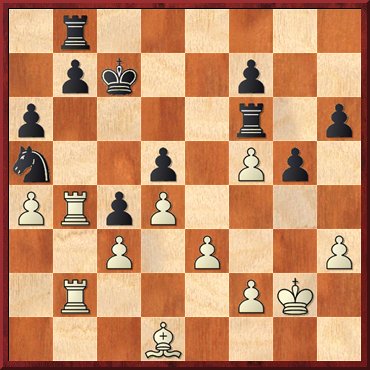
34.Bf3!
This temporary pawn sac is the only way
to play for an advantage. Now the pressure
starts to get to Keith’s Armenian opponent.
34...Rxf5? 34...Rd6! prevents White
from establishing base camp on b6. But White
could continue with 35.e4 dxe4 36.Bxe4 b6
and still have plenty of scope for a long
grind. 35.Rb6! Nb3 After this it’s
more or less a mopping up exercise. 35...Nc6
seems best when Keith had provisionally
intended to play 36.e4 but he expressed the
hope to me that he would have spotted
Black’s brilliant reply 36...Rxf3! 37.Kxf3
and now 37...Nxd4+! 38.cxd4 c3 deflecting
the b2 rook. Instead, after 35...Nc6, White
can create a remarkable zugzwang with
36.Rb1!! - despite the plethora of legal
moves available to Black, it turns out that
every one of them cedes material in one way
or another (e.g. knight moves lose the
h6–pawn, while rook moves lose the d or
b-pawns). Perhaps the least obvious is
36...a5 but then Keith’s idea of 37.e4!
works like a treat because Black’s c4–c3
idea would no longer deflect the black rook
because it has moved to a safer square.
36.Rxh6 Not just a pawn: White also
threatens Bg4, picking off the stranded
rook. So Black’s next move is forced.
36...g4 37.hxg4 Rg5 37...Rg8 38.Kg3 Rg7
39.Bd1 Rfg5 40.f4 R5g6 41.Rxg6 winning a
second pawn and, eventually, the game.
38.Rf6 b5 39.axb5 axb5 40.Ra2 Rg7 41.Ra7+
Kd8 42.Bxd5 Rxg4+ 43.Kf3 Rg7 44.Bxf7 Nd2+
45.Kf4 b4 46.Rd6+ 1-0
Tom Eckersley-Waites and Marcus Harvey
had two very creditable wins for Oxford on
the middle boards, against David Eggleston
and Simon Williams respectively, but it
wasn’t enough to change the destination of
the match points. The Ginger GM played an
interesting new idea in the Queen’s Indian
and seemed to be doing well but his attempt
to finish with a sacrificial flourish
backfired. I won’t annotate the game but
it’s worth playing through from the
download. Where things really fell apart for
Oxford was on board six, where Neil
Dickenson seemed to be winning but
inexplicably subsided into an endgame
disaster.
Round 2 - Division 1a
This report seems to be getting
inordinately long, perhaps because the
Saturday games struck me as so entertaining.
Rather more so, it strikes me, than the
rarefied games played in world championships
and super-tournaments. Not a tedious Berlin
Defence in sight, thankfully.
But now forward to Sunday: Division 1a
featured three very tight matches which may
have a significant bearing on the teams to
qualify for the Championship pool and those
who will have to play their games in the
departure lounge (a.k.a. the Relegation
Pool) later on in the season.
Barbican 1 and Wood Green have had a good
many close matches over the years but at
this moment in time Barbican 1 have slightly
the stronger squad, albeit with only the one
GM to Wood Green’s two. There were just
three decisive results, with two female
players, Jovanka Houska and Kanwal Bhatia
supplying full points for their respective
teams, and Lorin D’Costa beating Scottish GM
John Shaw to give Barbican 1 the points.
John Shaw gave up a couple of pawns for an
initiative on the black side of an English
opening but never got quite enough for it.
|
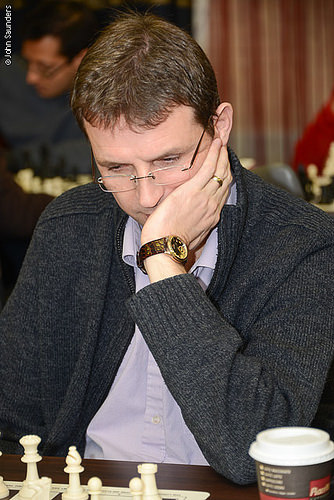 |
| Don
Mason |
White Rose versus Guildford 2 was another
tight match, with the Yorkshire side winning
by the minimum margin. The heavyweight
battles on the higher boards were hard
fought but drawn, so the lower boards were
left to produce decisive results. Nigel
Povah won for Guildford on bottom board, but
James Adair and Iain Gourlay replied in kind
for White Rose. Guildford 2’s hopes of a
match point were dashed when Sophie Milliet
lost on time against James Adair, one move
short of the time control, while a fraught
game between Colin McNab and Yang Fan-Zhou
might have gone either way before ending as
a draw.
Warwickshire Select had a tough time on
the top boards against The ADs, with Geoff
Lawton opening with the uninspiring 1.e4 d5
2.d3 and being ground down, and Don Mason
being given Merry hell in a tactical mêlée
on board two. To be fair, the loser deserves
equal billing with the winner for his part
in this hugely entertaining game, kicking
off a spirited and imaginative counter with
17...e5! which so nearly saved him.
4NCL
2014/15, Division 1a, Round 2
Alan
Merry (The ADs)
Don Mason
(Warwickshire Select)
1.e4 e6
2.d4 d5 3.Nc3 Bb4 4.e5 c5 5.a3 Bxc3+ 6.bxc3
Ne7 7.Qg4 Qc7 8.Bd3 cxd4 9.Ne2 dxc3 10.Qxg7
Rg8 11.Qxh7 Qxe5 12.h4 Rxg2 12...Nd7
13.Bf4 Qh8 (13...Qf6 14.Bg5 Qh8 gets us back
into familiar Winawer territory. In fact,
the game J.Jackson-N.Pert proceeded along
that path elsewhere at Hinckley on the same
day, and ended in a draw.) 14.Qxh8 Rxh8
15.Nxc3 a6 16.Bd6 f6 17.0‑0‑0 Kf7 18.Rde1
was played in Merry-Harika, PokerStars Isle
of Man International 2014, and won by White
in 69 moves. 13.Bg5 Ensuring that the
pawn-grabbing black rook will not have an
easy road back to safety. 13...Nbc6
13...Nd7, planning to travel to g6 via f8,
looks a safer option. 14.Kf1 Rh2
14...Rxg5!? 15.hxg5 Qxg5 16.Qh8+ Kd7 17.Rh5
Qg4 is probably a better option, though
White still has an initiative for his slight
material deficiency. 15.Rg1 Rh3 16.Re1
Qd6 17.Nf4
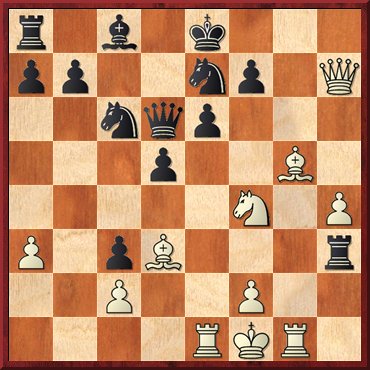
17...e5!
Black, in big trouble, tries to stir up
a tactical mess and, although it’s
objectively unsound, it’s a highly
imaginative practical try since 17...Rf3
18.Qh8+ Kd7 19.Qf6! e5 20.Qxf7 looks as
though it would lose without much of a
fight. 18.Qh8+ Here Houdini sees
about a gazillion moves ahead and finds
18.Bxe7!, which wins for reasons which only
become apparent in a few moves’ time. For
the time being, let’s just enjoy some human
chess... 18...Kd7 19.Nxh3 Has Black
simply hung a rook? No, he’s still in the
game... 19...Kc7! Black has a
mega-threat: Bxh3+ followed by Rxh8. Despite
White’s big material advantage, it’s not so
easy to find a way to capitalise. 20.Rg2!
20.Qf6 Bxh3+ 21.Ke2 Be6 gives Black a
reasonable chance of survival, though the
h5–pawn is a worry. 20...Bxh3 An
ingenious double rook sacrifice but Houdini
comes up with a more refined version of this
- 20...f6! - and good moves for White are
hard to find (particularly if you’re not
equipped with a dual core brain). Maybe
21.Be3!? when Houdini adjudges White to be a
bit better after 21...Bxh3 22.Qxa8 e4, etc.
21.Qxa8 e4 21...f6! is still good,
though now White has 22.Qh8 fxg5 23.hxg5
Bxg2+ 24.Kxg2 and is a fair bit better. Now
White has a couple of precise moves to find.
22.Bxe7! Qh2 Not 22...Nxe7 as White
switches focus with 23.Rb1! and Black never
gets the chance to deploy his counterplay
with Qh2. 23.Bxe4! 23.Qg8? comes
close to winning as well but there is a
sting in the tail: 23...Qh1+ 24.Ke2 exd3+
25.cxd3 Nd4+! 26.Ke3 Qxe1+ 27.Kxd4 Qxe7
28.Qg3+ Kc6 29.Qxh3 Qc5+ and it’s perpetual.
23...dxe4 24.Qg8!
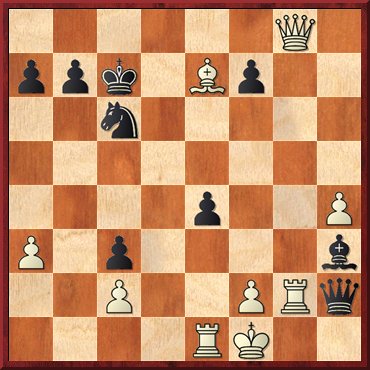
Now,
finally, we get to see why 20...f6 was so
important to Black, and get an idea why
18.Bxe7 was good for White previous to that.
Black needed a knight on e7 to stop the
white queen reaching its important defensive
post on g8. Of course, most humans can be
forgiven for missing such nuances, but it is
always instructive to work out what the
machine’s idea was. 24...Qh1+
Maddeningly for Black, after 24...Nxe7 White
has just the one good move, but that’s all
you need: 25.Qg3+! and it’s all over.
25.Ke2 Qxg2 Another heart-breaker for
Black. If 25...Nd4+ 26.Kd1 Qxg2, White only
has one really one convincing line, but
unfortunately it’s mate: 27.Qd8+ Kc6
28.Qd6+, etc. 26.Qxg2 Bxg2 27.Bf6 1-0
South Wales Dragons succumbed 1½-6½ to
Blackthorne Russia, losing on the top five
boards in various different ways. James Cobb
seemed to forget the en passant rule
at a critical juncture.
4NCL
2014/15, Division 1a, Round 2
Danny
Gormally (Blackthorne Russia)
James
Cobb (South Wales Dragons)
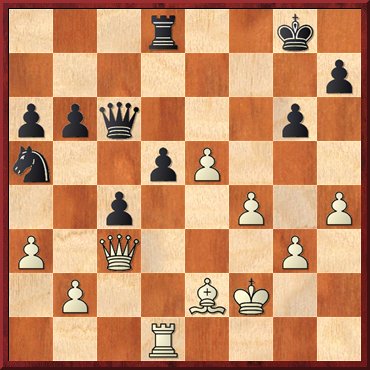
30.b4
Nb3?? Hard to understand. 30...cxb3
31.Qxc6 Nxc6 32.Rb1 Nd4 33.Bd1 Rc8 34.Bxb3
Rc5 gives Black a perfectly reasonable
chance of drawing. Black must have
perpetrated a major miscalculation of the
following tactics. 31.Bxc4! Creating
two pins (along the file and diagonal) for
the price of a self-pin (along the c-file).
It also threatens to unpin immediately with
Bd5+ so Black has to move his king off the
a2–g8 diagonal. 31...Kg7
Unfortunately for Black, 31...Kf8 is ruled
out because of the simple 32.Qxb3 dxc4
33.Rxd8+ Ke7 34.Qd1, etc. At least now the
knight is indirectly defended but the black
king is not yet safe from checks. 32.e6+
Kh6 33.f5 Rf8 A glimmer of counterplay
down the f-file? Perhaps this is where
Black’s calculations went wrong as White has
a decisive pair of intermezzo moves.
34.Qe3+ 1-0 34...Kg7 35.Qe5+ Rf6 36.Bxb3
is one winning line.
|
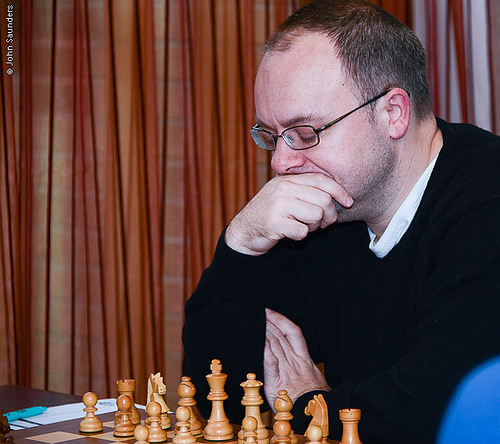 |
| Danny
Gormally |
Round 2 - Division 1b
Guildford 1 were untroubled by
e2e4.org.uk, winning five games and drawing
three. Board three featured a French GM and,
appropriately enough, a moment of déjà vu
for his English opponent. Do the French also
say “un moment senior”... ?
4NCL
2014/15, Division 1b, Round 2
Romain
Edouard (Guildford 2)
Peter
Sowray (e2e4.org.uk)
1.e4 e6
2.d4 d5 3.Nc3 Bb4 4.e5 c5 5.a3 Bxc3+ 6.bxc3
Ne7 7.Qg4 cxd4 8.Qxg7 Rg8 9.Qxh7 Qc7 10.Ne2
Nbc6 11.f4 Bd7 12.Qd3 dxc3 This has all
been seen before. White’s forthcoming plan
(shunting the h-pawn forward at full speed)
has also been seen before. 13.h4 0‑0‑0
14.h5 d4 15.h6 Rg6 16.h7 Rh8 17.Nxd4 Nxd4
18.Qxd4 Nf5 19.Qxa7 Qc6? Setting a
cheapo but simultaneously ruining his
chances. 20.Be3! Not falling for
20.Qa8+? Kc7 21.Qxh8?? and you don’t have to
be a genius to find a way to mate after
21...Qe4+, etc. 20...Qe4 21.Rh3
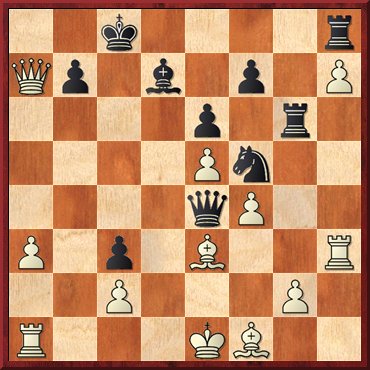
Now, the
curious thing about this position is that
Black had been here before. Thirty six years
ago (yes, Peter Sowray is really ancient -
almost as old as me, in fact) Peter had this
position against John Carleton (who also
found the nifty 20.Be3 move). Sadly, the
rules of the game haven’t changed in the
mean time and Black’s position is still as
atrocious as it was in 1978. His next move
can’t be considered an improvement as there
isn’t one. 21...Qxc2 At the Aaronson
Masters in 1978, Peter played 21...Rh6
against John Carleton, and the game
continued 22.0‑0‑0 Rxh3 23.Bb6! Qxf4+ 24.Kb1
Qa4 25.Qxa4 Bxa4 26.gxh3 Bc6 27.Rd8+ and
Black resigned. If 21...Qa4 22.0‑0‑0! Qxa7
23.Bxa7, White has two extra pawns plus the
monster h-pawn, which is unlikely to drop
off. 22.Rc1 Qb2 23.Qa8+ Kc7 24.Qa5+ Kc8
25.Rxc3+ Bc6 26.Bc1 Qb1 27.Rhd3 Ne7 28.Qa8+
Kc7 29.Qxh8 Nd5 30.Qf8 1-0
|
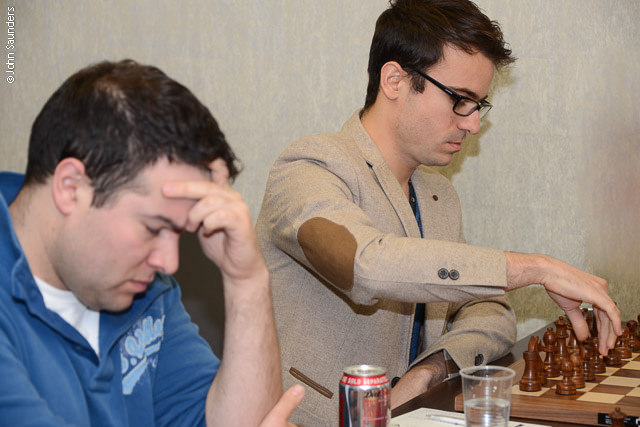 |
| Nick
Pert and Romain Eduoard |
Grantham Sharks versus Cheddleton was a
pretty close run thing, with the latter just
getting home by the odd point. What nearly
scuppered their chances was an
uncharacteristic endgame loss by Keith
Arkell on board five against 18-year-old
Peter Batchelor.
4NCL
2014/15, Division 1b, Round 2
Peter
Batchelor (Grantham Sharks)
Keith
Arkell (Cheddleton)
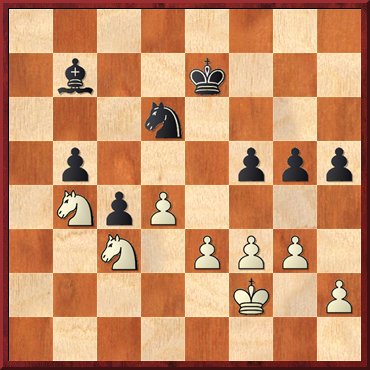
Black has
two passed pawns to White’s one but they are
both ideally blockaded by knights, just like
the textbooks tell us. White now provokes a
resolution of the kingside pawn situation.
38.h4 g4 I wonder if it might have
been better to play 38...gxh4 39.gxh4 when
the f5–pawn helps keep an eye on White’s e4
advance. But it’s hard to be sure.
39.fxg4 fxg4 Perhaps underestimating
White’s coming plan. 39...hxg4 has the
visual disadvantage of creating another
white passer but it is more important to
retain the f5–pawn to restrain White’s
central pawn advance. 40.d5! White’s
plan of advancing his central pawns in order
to infiltrate on the dark squares with his
king is simple and strong. Whether it should
actually win is another matter. 40...Kf6
41.e4 Ke5 42.Ke3 Ba8 The only move not
to cede material or give ground with the
king (which would be equally disastrous).
But White is almost as immobile - how is he
to make progress? 43.Na6! Bb7
43...Bxd5!? is very hard to break down after
44.exd5 Nf5+ 45.Kf2 Nd6!, when White has
great difficulty penetrating with his king.
44.Nb8 Threatening mate in one with
45.Nd7. 44...Nxe4? There doesn’t seem
to be a win for White after 44...Kf6! 45.Kd4
b4 46.e5+ Kf7 47.exd6 bxc3 48.Kxc3 Bxd5
49.Kd4 Be6 50.Nc6 Kf6, etc. White seems to
get knight plus the two kingside pawns
versus bishop and one (g) pawn, but the
white king can’t penetrate the black camp.
45.Nxe4 Bxd5 45...Kxd5 46.Nd7! weaves
a web round the black pieces and I’m pretty
sure there is no defence. The queenside
pawns are effectively immobilised: if
46...b4 47.Nb6+ and the c-pawn drops.
46.Nd7+ Kf5 47.Nc3 Bc6 48.Nb8 Be8 49.Na6 Bd7
50.Kd4 Kf6 51.Nc7 1-0
A half match point went begging on board
seven when White missed a fleeting chance to
win the game. The sort of soul-destroying
tactic the computer shows you when you key
your game in when you get home after a
match.
4NCL
2014/15, Division 1b, Round 2
Sam
Williams (Grantham Sharks)
David
Oswald (Cheddleton)
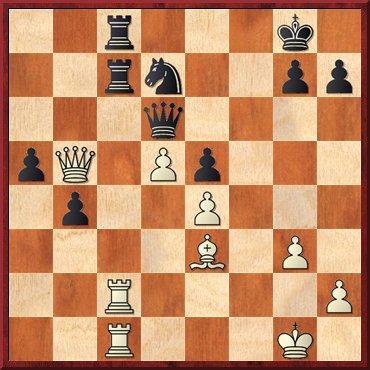
The game
went 39.Rc6? Rxc6 40.dxc6 Nf6 41.Qa6 Qe6
42.Qxa5 b3 and a draw was agreed on move
65. What White missed was 39.Rxc7! Rxc7
40.Rc6!! is decisive: 40...Rxc6 41.dxc6 Nf6
(or 41...Nf8 42.Qd5+! Qxd5 43.exd5 and a
pawn queens) 42.Qc4+! Kh8 43.c7 wins.
Only now do I notice... I made all those
existentialist word plays around Guillaume
Camus’s name in the round one section of the
report and completely overlooked the fact
that his team’s board one was called
John-Paul. An open goal and I missed it. Oh
well, I’ll leave you to make up your own
jokes this time and stick to the chess.
Cambridge University brought off a handsome
win against Hackney thanks to three decisive
wins and no losses. However, at least one of
the wins might have gone the other way but
for a diabolical trick.
4NCL
2014/15, Division 1b, Round 2
Tomer
Eden (Hackney)
Daniel
Bisby (Cambridge University)
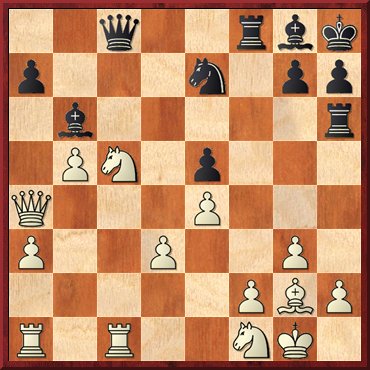
White has
three extra pawns but things start going
wrong very quickly. 42.Qb4? Giving
back one pawn with 42.d4!? exd4 to be able
to secure the f2–pawn with 43.Nd3 is one
prudent line. 42...Rhf6! 43.d4 There
is no good way to defend the f2–pawn as
43.f3 allows tricks such as 43...Nc6!?
44.bxc6 Rxc6, regaining some material and
reaching a probably drawn position.
43...Rxf2 44.Nd3 Simultaneously
attacking the queen and the rook, but Black
has a useful counter. 44...Rxg2+!?
45.Kxg2 Qg4! 46.Nc5?? 46.Qxe7 allows a
draw with 46...Qf3+ 47.Kh3 Qh5+, etc, but if
White but knew it, it is in fact the only
line not to lose. He thinks he only has to
worry about the black queen and rook, but
Black can bring a third piece to bear on the
kingside, with deadly effect. 46...Nd5!
47.Qd2 47.exd5 Bxd5+ 48.Kg1 Qf3 wins.
47...Nf4+ 48.Kf2 48.Kg1 Nh3+ 49.Kh1 Nf2+
50.Kg1 Qf3 wins. 48...Ne2+ 0-1 49.Ke1
Nxd4 soon wins.
This game, by a genuine Cambridge
undergraduate, had a delicious finish.
|
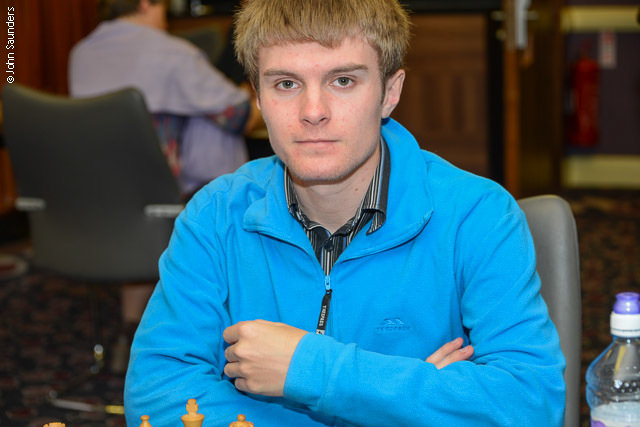 |
| Andrew
McClement |
4NCL
2014/15, Division 1b, Round 2
Nicholas
Walker (Hackney)
Andrew
McClement (Cambridge University)
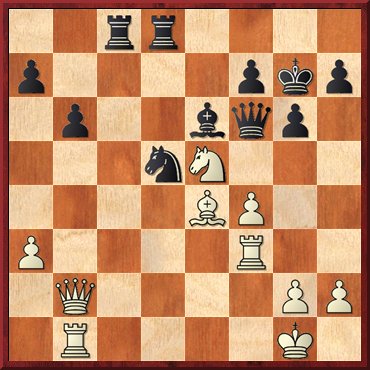
Black is a
comfortable pawn up and now finds a clever
tactical justification for snatching a
second one. 24...Nxf4! 25.g3 Rd4!! 26.Bb7
If 26.Qxd4 Ne2+ 27.Kh1 Nxd4 28.Rxf6 Kxf6
and Black emerges with his two extra pawns
intact, and actually a useful positional
plus to boot. 26.Rxf4 Qxe5 also leaves Black
with a comfortable +2 advantage.
26...Qxe5! 27.gxf4 27.Bxc8 Rd1+! wins,
much as in the game. If 28.Kf2 Nh3+ 29.Kg2
Qxb2+ 30.Rxb2 Rg1 mate. 27...Rd1+! 28.Kf2
Rc2+! 0‑1 Not the only winning move but
the most aesthetically pleasing (having
previously put the other rook en prise to
the queen). The idea is to break the pin and
deliver mate, thus 29.Qxc2 Qe1+ 30.Kg2 Qg1
mate.
Oxford scored a useful 5-3 victory over
Barbican 2. The board seven game was rather
fun, and a good way to finish this rather
long report.
4NCL
2014/15, Division 1b, Round 2
Jonathan
Manley (Oxford)
Terry
Chapman (Barbican 2)
1.e4 d6
2.d4 Nf6 3.Nc3 e5 4.Nf3 Nbd7 5.Bc4 Be7 6.0‑0
Nb6 To give you an idea of how
respectable this line of Philidor’s Defence
is, the game Carlsen-Caruana from the 2014
World Rapidplay Championship reached this
position before diverging with 6...exd4,
etc. 7.Be2 exd4 8.Nxd4 0‑0 9.a4 a5 10.f4
d5!? A new move and maybe not bad,
though it needs to be followed up with care
as the white e and f-pawns are menacing
marching up the board together. 11.e5 Ne4
12.f5 Nxc3 12...Bc5!? looks interesting,
though White still might plunge on with
13.f6 g6 14.Kh1 Re8 15.Bf4, etc. 13.bxc3
c5 13...f6 14.e6 14.f6!
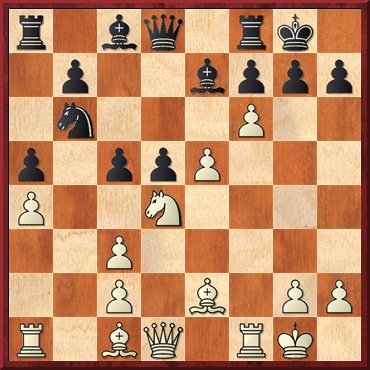
A good,
old-fashioned attack on the king, and very
hard to defend. 14...gxf6 Loses
quickly. So Black probably has to play
14...cxd4 15.fxe7 Qxe7 16.cxd4 though that
too looks promising for White as he’s
threatening Ba3, and maybe a rook lift and
an assault on the king. 15.Bd3!
15.exf6 first also seems to win.
15...fxe5 15...cxd4 16.Qh5 f5 17.Rxf5!
soon leads to mate. 16.Bxh7+! Our old
friend, the Greek gift. 16...Kxh7 17.Qh5+
Kg8 18.Rf3 18.Nf5 Bxf5 19.Rxf5 Qd6
20.Rf3 wins the queen a bit quicker but
comes to the same thing. 18...Bh4 19.Nf5
Bxf5 20.Rxf5 1-0 There’s no mate as such
but only a masochist would want to prolong
the agony with 20...Qd6 21.Qxh4 f6 22.Qh5
Rf7 23.Bh6 Qe7 24.Raf1 Nd7 25.R1f3, etc,
etc.
|
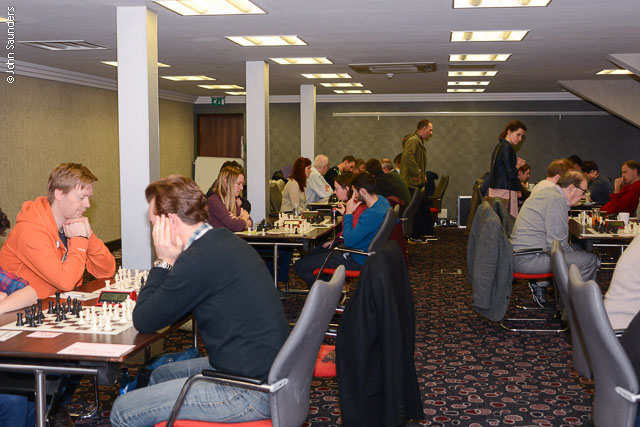 |
| Wood
Green v Warwicks, The ADs v Barbican
1 |
Scores after Round 2
Division 1a: 1 White Rose 4(10½), 2
Barbican 1 4(10), 3 Blackthorne Russia
2(9½), 4 Guildford 2 2(8½), 5 Wood Green HK
2(8), 6 The ADs 2(7½), 7 Warwickshire Select
0(6½), 8 South Wales Dragons 0(3½).
Division 1b: 1 Guildford 1 4(13), 2
Cambridge University 4(10), 3 Cheddleton
4(9), 4 Grantham Sharks 2(8½), 5 Oxford
2(8½), 6 Barbican 2 0(6), 7 e2e4.org.uk
0(5), 8 Hackney 0(4).
Division 2a: 1 Cambridge University 2
4(12½), 2 3Cs 4(11½), 3 Anglian Avengers
2(7), 4 Rhyfelwyr Essyllwg 2(7), 5 Brown
Jack Witney 2(6½), 6 Sussex Martlets 2(6½),
7 Guildford 3 0(7), 8 KJCA Kings 0(6).
Division 2b: 1 Barbican Youth 4(10), 2
Spirit of Atticus 4(9½), 3 White Rose 2
2(8½), 4 MK Phoenix 2(8), 5 BCM Dragons
2(7½), 6 Grantham Sharks 2 1(7½), 7 Wessex
1(7), 8 Kings Head 0(6).
Annotated games from the
above report |
Download
in PGN |
Photos ©
John Saunders
|


![]()